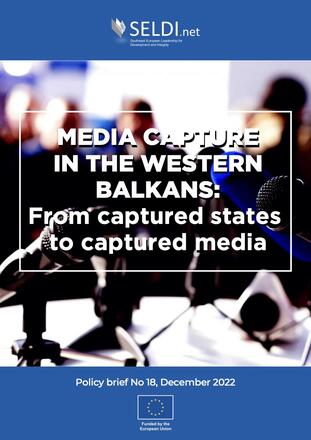
The paper defines media capture by pointing out certain patterns indicative of strong influence of governments and private actors, such as control of regulatory bodies, weak media regulation and financial struggle of public broadcasters, which gives way to political interference as the government acts as the main financial resource provider. The brief clearly depicts governments as main captors, which can be seen as a consequence of the wider problem of state capture, a systematic corruption issue in which private interests impact state decision-making.
Four manifestations of media capture are pointed out in particular:
- Media ownership concentration and financing- While the media is usually highly fragmented with many outlets, this does not necessarily imply media pluralism, as the ownership is often obscure and lacks transparency. The brief describes a case study of Telekom Srbija, a state-owned media provider correlated to government loyalists. It is seen as one of the key instruments for the media capture in Serbia.
- (In)dependent regulatory bodies - Tight political grip on those bodies leads to them not regulating the media landscape in a way that promotes media pluralism and freedom, but instead furthering the agenda of politicians. The main problem lies in the fact that usually media regulators are politically appointed.
- Public Broadcasters - The conversion of state-controlled broadcasters from communist times into public service broadcasters was seen by the new elites as a chance to increase their control. Nowadays, most public broadcasters in the WB region are seen as dominated by the ruling parties.
- Disinformation - Disinformation campaigns, such as those orchestrated by Moscow to influence public opinion and disrupt NATO and EU enlargement efforts, are prevalent in the region. For starters, certain media outlets in Serbia at the start of the Russian invasion of Ukraine were reporting how it was the Ukranians that were the aggressors. “Fake news” is implemented as a political strategy for elections and influence on public opinion.
A number of recommendations are pointed out in order to tackle the media capture problem. It should be analysed as a distinct phenomenon from media freedom in general, as this will allow better examination of mechanisms that enable political influence. Legislation guaranteeing media ownership transparency should be adopted, preventing ownership concentration. Public funding of media outlets should be more transparent, so the politicians are not able to leverage it. Improvement of legal frameworks in order to ensure the independence of media regulatory bodies. Finally, disinformation should be tackled both on the national and the EU level, given that it has an evident geopolitical dimension.
Publication Date: December 2022
Tags: Media capture Media freedom Media pluralism Media ownership Albania Serbia Kosovo Bosnia Herzegovina Montenegro North MacedoniaThe content of this article can be used according to the terms of Creative Commons: Attribution-NonCommercial 4.0 International (CC BY-NC 4.0) . To do so use the the wording "this article was originally published on the Resource Centre on Media Freedom in Europe" including a direct active link to the original article page.

